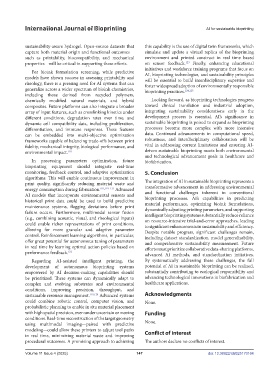Page 155 - v11i4
P. 155
International Journal of Bioprinting AI for sustainable bioprinting
sustainability-aware hydrogel. Open-source datasets that this capability is the use of digital twin frameworks, which
capture both material origin and functional outcomes— simulate and update a virtual replica of the bioprinting
such as printability, biocompatibility, and mechanical environment and printed construct in real time based
properties—will be critical in supporting these efforts. on sensor feedback. Finally, enhancing educational
123
initiatives and workforce training programs that focus on
For bioink formulation screening, while predictive
models have shown success in assessing printability and AI, bioprinting technologies, and sustainability principles
will be essential to build interdisciplinary expertise and
rheology, there is a pressing need for AI systems that can foster widespread adoption of environmentally responsible
generalize across a wider spectrum of bioink chemistries, bioprinting practices. 124,125
including those derived from recycled polymers,
chemically modified natural materials, and hybrid Looking forward, as bioprinting technologies progress
composites. Future platforms can also integrate a broader toward clinical translation and industrial adoption,
array of input features, such as crosslinking kinetics under integrating sustainability considerations early in the
different conditions, degradation rates over time, and development process is essential. AI’s significance in
dynamic cell compatibility data, including proliferation, sustainable bioprinting is poised to expand as bioprinting
differentiation, and immune responses. These features processes become more complex with more intensive
can be embedded into multi-objective optimization data. Continued advancements in computational speed,
frameworks capable of balancing trade-offs between print robustness, and interdisciplinary collaboration will be
fidelity, mechanical integrity, biological performance, and vital in addressing current limitations and ensuring AI-
environmental impact. 118 driven sustainable bioprinting meets both environmental
and technological advancement goals in healthcare and
In processing parameters optimization, future biofabrication.
bioprinting equipment should integrate real-time
monitoring, feedback control, and adaptive optimization 5. Conclusion
algorithms. This will enable continuous improvement in
print quality, significantly reducing material waste and The integration of AI in sustainable bioprinting represents a
energy consumption during fabrication. 101,119–121 Advanced transformative advancement in addressing environmental
AI models that incorporate environmental sensors and and functional challenges inherent in conventional
historical print data could be used to build predictive bioprinting processes. AI’s capabilities in predicting
maintenance systems, flagging deviations before print material performance, optimizing bioink formulations,
failure occurs. Furthermore, multimodal sensor fusion dynamically adjusting printing parameters, and supporting
intelligent bioprinting systems substantially reduce reliance
(e.g., combining acoustic, visual, and rheological inputs) on resource-intensive trial-and-error approaches, leading
could enable richer representations of print conditions, to significant enhancements in sustainability and efficiency.
allowing for more granular and adaptive parameter Despite notable progress, significant challenges remain,
control. Reinforcement learning algorithms, in particular, including dataset standardization, model generalizability,
offer great potential for autonomous tuning of parameters and comprehensive sustainability measurement. Future
in real time by learning optimal action policies based on efforts must prioritize collaborative data-sharing platforms,
performance feedback. 122 advanced AI methods, and standardization initiatives.
Regarding AI-assisted intelligent printing, the By systematically addressing these challenges, the full
development of autonomous bioprinting systems potential of AI in sustainable bioprinting can be realized,
empowered by AI decision-making capabilities should substantially contributing to ecological responsibility and
be prioritized. These systems can dynamically adapt to advancing technological innovations in biofabrication and
complex and evolving substrates and environmental healthcare applications.
conditions, improving precision, throughput, and
sustainable resource management. 119,120 Advanced systems Acknowledgments
could combine robotic control, computer vision, and None.
probabilistic planning to enable in situ material placement
with high spatial precision, even under uncertain or moving Funding
conditions. Real-time reconstruction of the target geometry
using multimodal imaging—paired with predictive None.
modeling—could allow these printers to adjust tool paths
in real time, minimizing material waste and improving Conflict of interest
procedural outcomes. A promising approach to achieving The authors declare no conflicts of interest.
Volume 11 Issue 4 (2025) 147 doi: 10.36922/IJB025170164

